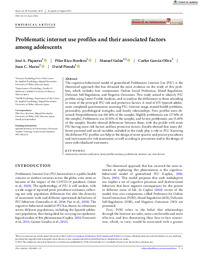Por favor, use este identificador para citar o enlazar este ítem:
https://hdl.handle.net/11000/35030Registro completo de metadatos
| Campo DC | Valor | Lengua/Idioma |
|---|---|---|
| dc.contributor.author | Piqueras, Jose A | - |
| dc.contributor.author | Rico Bordera, Pilar | - |
| dc.contributor.author | Galán, Manuel | - |
| dc.contributor.author | García Oliva, Carlos | - |
| dc.contributor.author | Marzo Campos, Juan Carlos | - |
| dc.contributor.author | Pineda, David | - |
| dc.contributor.other | Departamentos de la UMH::Psicología de la Salud | es_ES |
| dc.date.accessioned | 2025-01-20T12:44:55Z | - |
| dc.date.available | 2025-01-20T12:44:55Z | - |
| dc.date.created | 2024-08 | - |
| dc.identifier.citation | J Res Adolesc. 2024;00:1–15 | es_ES |
| dc.identifier.issn | 1532-7795 | - |
| dc.identifier.issn | 1050-8392 | - |
| dc.identifier.uri | https://hdl.handle.net/11000/35030 | - |
| dc.description.abstract | The cognitive- behavioral model of generalized Problematic Internet Use (PIU) is the theoretical approach that has obtained the most evidence on the study of this problem, which includes four components: Online Social Preference, Mood Regulation, Deficient Self- Regulation, and Negative Outcomes. This study aimed to identify PIU profiles using Latent Profile Analysis, and to analyze the differences in them attending to some of the principal PIU risk and protective factors. A total of 675 Spanish adolescents completed questionnaires assessing PIU, Internet usage, mental health problems, personality, psychological strengths, and family relationships. Four profiles were obtained: Nonproblematic use (68.30% of the sample), Slightly problematic use (17.90% of the sample), Problematic use (8.50% of the sample), and Severe problematic use (5.40% of the sample). Results showed differences between them, with the profile with more PIU having more risk factors and less protective factors. Results showed that many different personal and social variables included in the study play a role in PIU. Knowing the different PIU profiles can help in the design of more specific and precise procedures and instruments for risk assessment, as well as aiding in prevention and in the design of more individualized treatments. | es_ES |
| dc.format | application/pdf | es_ES |
| dc.format.extent | 15 | es_ES |
| dc.language.iso | eng | es_ES |
| dc.publisher | Wiley | es_ES |
| dc.rights | info:eu-repo/semantics/openAccess | es_ES |
| dc.rights | Attribution-NonCommercial-NoDerivatives 4.0 Internacional | * |
| dc.rights.uri | http://creativecommons.org/licenses/by-nc-nd/4.0/ | * |
| dc.subject | adolescents | es_ES |
| dc.subject | internet addiction | es_ES |
| dc.subject | latent profile analysis | es_ES |
| dc.subject | problematic internet use | es_ES |
| dc.subject | risk factors | es_ES |
| dc.subject.other | CDU::1 - Filosofía y psicología::159.9 - Psicología | es_ES |
| dc.title | Problematic internet use profiles and their associated factors among adolescents | es_ES |
| dc.type | info:eu-repo/semantics/article | es_ES |
| dc.relation.publisherversion | https://doi.org/10.1111/jora.13014 | es_ES |

Ver/Abrir:
Piqueras et al., 2024 (1).pdf
900,6 kB
Adobe PDF
Compartir:
 La licencia se describe como: Atribución-NonComercial-NoDerivada 4.0 Internacional.
La licencia se describe como: Atribución-NonComercial-NoDerivada 4.0 Internacional.
.png)